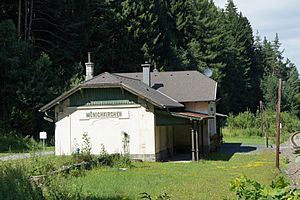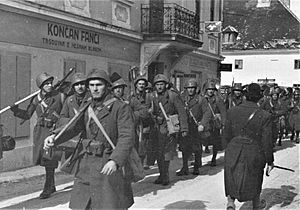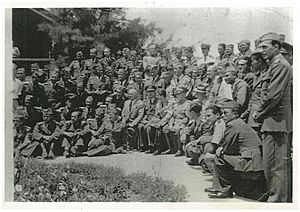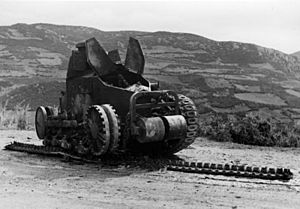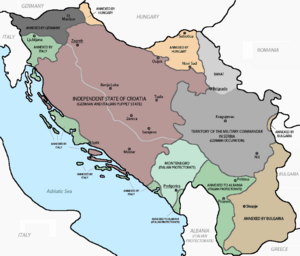Invasion of Yugoslavia facts for kids
Quick facts for kids Invasion of Yugoslavia |
|||||||||
|---|---|---|---|---|---|---|---|---|---|
| Part of the Balkans Campaign of World War II | |||||||||
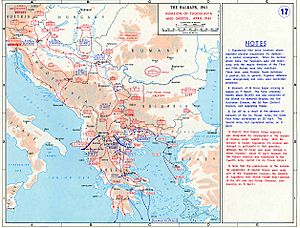 Map illustrating the movements of the Axis forces in Yugoslavia and Greece |
|||||||||
|
|||||||||
| Belligerents | |||||||||
| Axis: | |||||||||
| Commanders and leaders | |||||||||
|
|||||||||
| Strength | |||||||||
| Germany: 337,096 875 tanks 990 aircraft Italy: 300,000 in 22 divisions 666 aircraft Hungary: 9 brigades 6 air squadrons |
700,000 (400,000 ill-prepared) 110–200 tanks (50–54 of which were modern) 460–505 aircraft (including 103 modern bombers and 107 modern fighters) |
||||||||
| Casualties and losses | |||||||||
| Germany: 151 killed 392 wounded 15 missing 40 aircraft shot down Italy: 3,324 killed or wounded 10+ aircraft shot down 22 aircraft damaged Hungary: 120 killed 223 wounded 13 missing 7 aircraft shot down |
Thousands of civilians & soldiers killed 254,000–345,000 captured (by the Germans) 30,000 captured (by the Italians) 49 aircraft shot down 103 pilots & aircrew killed 210–300 aircraft captured 3 destroyers captured 3 submarines captured |
||||||||
The invasion of Yugoslavia, also called the April War, was a quick attack on the Kingdom of Yugoslavia by the Axis powers (Germany, Italy, and Hungary) during World War II. It began on April 6, 1941. The German leader, Adolf Hitler, ordered the invasion after a new government in Yugoslavia overthrew the old one that was friendly to the Axis.
The attack started with a huge air raid on Yugoslavia's capital, Belgrade, and its air force bases. German ground forces then invaded from different directions. Italian and Hungarian forces joined the attack a few days later. The Yugoslav army quickly fell apart.
Historians have different ideas why Yugoslavia collapsed so fast. Some say it was because of poor training and old equipment. Others point to internal conflicts among different groups in Yugoslavia. The invasion ended on April 17, 1941, when Yugoslavia surrendered without conditions. The country was then divided up and occupied by the Axis powers. This invasion was part of the larger Balkan Campaign during World War II.
Why the Invasion Happened: Background
In October 1940, Italy attacked Greece, but the Greek army pushed them back. Adolf Hitler of Germany wanted to help his ally, Benito Mussolini of Italy. He also wanted to stop Britain from bombing oil fields in Romania, which Germany needed for the war.
In 1940 and early 1941, Hungary, Romania, and Bulgaria joined the Tripartite Pact. This was an agreement between Germany, Italy, and Japan. Hitler then pressured Yugoslavia to join too. Prince Paul, who was ruling Yugoslavia, agreed on March 25, 1941.
However, many people in Yugoslavia, especially Serbian military officers, did not like this decision. On March 27, 1941, these officers staged a coup. They forced Prince Paul to step down and declared the 17-year-old King Peter II as the new ruler.
Getting Ready for War: Preparation
When Hitler heard about the coup in Yugoslavia, he was very angry. He saw it as a personal insult. On March 27, 1941, he ordered his military to "destroy Yugoslavia militarily and as a state." He wanted this done "without waiting for possible declarations of loyalty of the new government."
Hungary had signed a peace treaty with Yugoslavia in December 1940. But after Hitler's order, Hungary decided to join the invasion. They said the treaty would no longer apply if Yugoslavia broke apart. When a new Croatian government declared independence on April 10, Hungary joined the attack.
On April 1, Yugoslavia renamed its special forces to "Chetnik Command." These forces were meant to fight a guerrilla war if the country was taken over. On April 2, Germany told its embassy staff to leave Belgrade. This was a clear sign that an invasion was coming.
Who Fought: Opposing Forces
The Axis powers had a very strong military for the invasion. Germany led the attack with many divisions, including powerful tank units. They also had huge air support from the Luftwaffe (German Air Force). Italy and Hungary also sent many soldiers and aircraft.
Germany attacked Yugoslavia from several countries: Hungary, Romania, and Bulgaria. German troops had entered these countries earlier for different reasons. For example, they were in Romania to protect oil fields and prepare for other attacks.
Axis Military Power
Germany's main attack force included 19 divisions, with five tank divisions and two mountain divisions. They had over 750 aircraft. Italy sent 22 divisions and 666 aircraft. Hungary sent 9 brigades and 6 air squadrons.
Hitler's main command center during the war was a special train called "Frühlingssturm" (Spring Storm). It was located in Mönichkirchen, Austria, near a rail tunnel for protection.
Yugoslavia's Military Strength
The Royal Yugoslav Army had more than 33 divisions. The Royal Yugoslav Air Force had over 400 aircraft. The Royal Yugoslav Navy was small, with four destroyers and four submarines.
Most of Yugoslavia's equipment was old, from World War I. They had about 4,000 artillery pieces, but many were outdated. Only about 50 of their tanks were modern enough to fight German tanks. The air force had some modern planes, but not enough to match the Axis.
The Yugoslav army was still getting ready when the invasion started. Only about 11 divisions were in their planned defense spots. Yugoslavia had delayed full mobilization to avoid making Hitler angry.
The Yugoslav army also had problems because of internal disagreements between Serbs and Croats. Many non-Serb groups were not willing to fight for a "Serbian Yugoslavia." This weakened their defense. On April 10, some Croatian units even rebelled, and a new Croatian government welcomed the Germans into Zagreb.
How the Invasion Happened: Operations
The invasion had two main parts. First, the German air force launched a massive attack on Belgrade and Yugoslav airfields on April 6. Then, German ground forces attacked from different directions. Italy and Hungary joined the ground attack on April 11.
Air Attacks: Bombing Belgrade
On April 6, 1941, the German air force started "Operation Retribution." About 300 German planes, including dive-bombers and medium bombers, attacked Belgrade. They flew in waves, bombing the city for almost an hour and a half.
This attack destroyed many buildings and killed about 4,000 people. It also cut off communication between the Yugoslav high command and its forces. After this, the German air force focused on military targets like airfields and troop movements.
The Yugoslav air force tried to defend Belgrade. Their fighters shot down about 20 German planes on April 6 and another dozen on April 7. But they lost many of their own planes in the process.
After 11 days, the Yugoslav air force was almost completely destroyed. However, some planes were still being built and delivered during the invasion. A few Yugoslav planes managed to escape to Greece and Egypt.
Ground Attacks: The Advance
German forces attacked from Bulgaria, Austria, Romania, and Hungary. They quickly broke through Yugoslav defenses. By April 11, German tank columns were all over Yugoslavia. The only strong resistance left was around the capital.
On April 12, German troops captured Belgrade. The city surrendered to a small group of German officers who bluffed about their strength.
Italian and Hungarian Offensives
Italy's ground attack began on April 11. Their forces attacked from northeastern Italy towards Ljubljana and the Dalmatian coast. They met very little resistance. They captured major cities like Ljubljana, Sušak, and Split.
On the same day, the Hungarian army crossed the border into Yugoslavia. They advanced towards Novi Sad and also faced little resistance. Hungarian forces only occupied areas that were part of Hungary before World War I.
Yugoslav Counter-Attack in Albania
Yugoslavia's war plan included an attack on Italian forces in northern Albania. This was meant to create a safe path for the main Yugoslav army to retreat south to Greece.
On April 7, the 3rd Yugoslav Army launched its attack in Albania. They made some progress, but German troops appearing in other areas forced them to stop. Italian code breakers also helped by sending fake orders to Yugoslav troops, causing confusion.
By April 11, the Yugoslav forces in Albania were forced to retreat.
The Royal Yugoslav Navy had three destroyers, two submarines, and 10 motor torpedo boats. One destroyer was in dry-dock and its guns were used for defense.
The navy tried to attack the Italian area of Zara (Zadar) on the coast. But their destroyer, Beograd, was damaged by Italian planes and had to retreat. Italian air raids also damaged other Yugoslav ships.
Yugoslav naval planes flew missions, attacking Italian convoys and ports. One plane even attacked a convoy of 12 ships by itself.
The Yugoslav navy also had four heavily armed river monitors on the Danube, Drava, and Sava rivers. They shelled Hungarian airfields. But on April 12, German dive-bombers attacked them. One monitor, Drava, was sunk when a bomb went straight down its funnel, killing most of its crew. The other three monitors were sunk by their own crews to prevent them from being captured.
What Happened Next: Aftermath
The Axis powers won very quickly. On April 14, the Yugoslav high command decided to surrender. On April 17, after only eleven days of fighting, Yugoslavia officially surrendered. The agreement took effect on April 18.
Historians debate why Yugoslavia collapsed so fast. Some say it was due to poor training and equipment, or generals who wanted to end the fighting quickly. Others point to internal divisions, especially among Croats, Slovenes, and Germans, who might have helped the invaders. However, some scholars believe these internal groups had little effect on the final outcome.
After the surrender, Yugoslavia was divided among Germany, Hungary, Italy, and Bulgaria. Germany took control of most of Serbia. A new state called the Independent State of Croatia was created, but it was controlled by Germany and Italy.
Even after the surrender, resistance against the Axis occupation began. Royal Yugoslav Army Colonel Draža Mihailović started organizing a resistance group in the mountains. Later, the Yugoslav Partisans led by Josip Tito also began fighting the Axis. These groups continued to resist the occupying armies until the end of the war.
Images for kids


